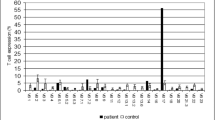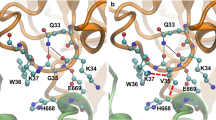Abstract
Mutations in Recombination Activating Genes (RAG1 and RAG2) are common genetic causes of severe combined immunodeficiency (SCID) and Omenn syndrome (OS). The clinical, immunologic, and genetic characteristics of RAG mutations in Chinese patients with SCID or OS have not been studied in detail. In this research, 22 RAG mutations were identified in 15 Chinese patients, including 10 novel mutations in RAG1 (R108X, M630T, E510X, S666P, E669K, C730Y, A857V, K847E, L922PfsX7, and L1025FfsX39) and 4 in RAG2 (R73C, I427GfsX12, P432L, and 311insL). L1025FfsX39 is a potential RAG1 hot-spot mutation in the Chinese population. The distribution of RAG1 mutations rather than mutation type seemed to differ between SCID and OS patients. The thymic output of T lymphocytes, TCR rearrangement, and T cell proliferation were severely impaired in RAG mutant patients. These findings will contribute to the early diagnosis and treatment of SCID and OS to a certain extent.



Similar content being viewed by others
References
Cirillo E, Giardino G, Gallo V, D’Assante R, Grasso F, Romano R, et al. Severe combined immunodeficiency-an update. Ann N Y Acad Sci. 2015. doi:10.1111/nyas.12849.
Bogaert D, Van Schil K, Taghon T, Bordon V, Bonroy C, Dullaers M, et al. Persistent rotavirus diarrhea post-transplant in a novel JAK3-SCID patient after vaccination. Pediatr Allergy Immunol. 2015. doi:10.1111/pai.12455.
McBlane JF, van Gent DC, Ramsden DA, Romeo C, Cuomo CA, Gellert M, et al. Cleavage at a V(D)J recombination signal requires only RAG1 and RAG2 proteins and occurs in two steps. Cell. 1995;83(3):387–95.
Oettinger MA, Schatz DG, Gorka C, Baltimore D. RAG-1 and RAG-2, adjacent genes that synergistically activate V(D)J recombination. Science. 1990;248(4962):1517–23.
van Gent DC, Ramsden DA, Gellert M. The RAG1 and RAG2 proteins establish the 12/23 rule in V(D)J recombination. Cell. 1996;85(1):107–13.
Schwarz K, Gauss GH, Ludwig L, Pannicke U, Li Z, Lindner D, et al. RAG mutations in human B cell-negative SCID. Science. 1996;274(5284):97–9.
Villa A, Santagata S, Bozzi F, Giliani S, Frattini A, Imberti L, et al. Partial V(D)J recombination activity leads to Omenn syndrome. Cell. 1998;93(5):885–96.
Kato M, Kimura H, Seki M, Shimada A, Hayashi Y, Morio T, et al. Omenn syndrome—review of several phenotypes of Omenn syndrome and RAG1/RAG2 mutations in Japan. Allergol Int. 2006;55(2):115–9. doi:10.2332/allergolint.55.115.
Niehues T, Perez-Becker R, Schuetz C. More than just SCID–the phenotypic range of combined immunodeficiencies associated with mutations in the recombinase activating genes (RAG) 1 and 2. Clin. Immunol. 2010;135(2):183–92. doi:10.1016/j.clim.2010.01.013.
Kuijpers TW, Ijspeert H, van Leeuwen EM, Jansen MH, Hazenberg MD, Weijer KC, et al. Idiopathic CD4+ T lymphopenia without autoimmunity or granulomatous disease in the slipstream of RAG mutations. Blood. 2011;117(22):5892–6. doi:10.1182/blood-2011-01-329052.
Ij H, Driessen GJ, Moorhouse MJ, Hartwig NG, Wolska-Kusnierz B, Kalwak K, et al. Similar recombination-activating gene (RAG) mutations result in similar immunobiological effects but in different clinical phenotypes. J Allergy Clin Immunol. 2014;133(4):1124–33. doi:10.1016/j.jaci.2013.11.028.
Zhang ZY, Zhao XD, Jiang LP, Liu EM, Cui YX, Wang M, et al. Clinical characteristics and molecular analysis of three Chinese children with Omenn syndrome. Pediatr Allergy Immunol. 2011;22(5):482–7. doi:10.1111/j.1399-3038.2010.01126.x.
Lee PP, Chan KW, Chen TX, Jiang LP, Wang XC, Zeng HS, et al. Molecular diagnosis of severe combined immunodeficiency–identification of IL2RG, JAK3, IL7R, DCLRE1C, RAG1, and RAG2 mutations in a cohort of Chinese and Southeast Asian children. J Clin Immunol. 2011;31(2):281–96. doi:10.1007/s10875-010-9489-z.
Ryu KH, Cho KA, Park HS, Kim JY, Woo SY, Jo I, et al. Tonsil-derived mesenchymal stromal cells: evaluation of biologic, immunologic and genetic factors for successful banking. Cytotherapy. 2012;14(10):1193–202. doi:10.3109/14653249.2012.706708.
Wu J, Liu D, Tu W, Song W, Zhao X. T-cell receptor diversity is selectively skewed in T-cell populations of patients with Wiskott-Aldrich syndrome. J Allergy Clin Immunol. 2015;135(1):209–16. doi:10.1016/j.jaci.2014.06.025.
Dion ML, Sekaly RP, Cheynier R. Estimating thymic function through quantification of T-cell receptor excision circles. Methods Mol Biol. 2007;380:197–213. doi:10.1007/978-1-59745-395-0_12.
Miyara M, Yoshioka Y, Kitoh A, Shima T, Wing K, Niwa A, et al. Functional delineation and differentiation dynamics of human CD4+ T cells expressing the FoxP3 transcription factor. Immunity. 2009;30(6):899–911. doi:10.1016/j.immuni.2009.03.019.
Shearer WT, Dunn E, Notarangelo LD, Dvorak CC, Puck JM, Logan BR, et al. Establishing diagnostic criteria for severe combined immunodeficiency disease (SCID), leaky SCID, and Omenn syndrome: the Primary Immune Deficiency Treatment Consortium experience. J Allergy Clin Immunol. 2014;133(4):1092–8. doi:10.1016/j.jaci.2013.09.044.
Villa A, Sobacchi C, Notarangelo LD, Bozzi F, Abinun M, Abrahamsen TG, et al. V(D)J recombination defects in lymphocytes due to RAG mutations: severe immunodeficiency with a spectrum of clinical presentations. Blood. 2001;97(1):81–8.
Corneo B, Moshous D, Gungor T, Wulffraat N, Philippet P, Le Deist FL, et al. Identical mutations in RAG1 or RAG2 genes leading to defective V(D)J recombinase activity can cause either T-B-severe combined immune deficiency or Omenn syndrome. Blood. 2001;97(9):2772–6.
Ji Y, Little AJ, Banerjee JK, Hao B, Oltz EM, Krangel MS, et al. Promoters, enhancers, and transcription target RAG1 binding during V(D)J recombination. J Exp Med. 2010;207(13):2809–16. doi:10.1084/jem.20101136.
Jung D, Giallourakis C, Mostoslavsky R, Alt FW. Mechanism and control of V(D)J recombination at the immunoglobulin heavy chain locus. Annu Rev Immunol. 2006;24:541–70. doi:10.1146/annurev.immunol.23.021704.115830.
Couedel C, Roman C, Jones A, Vezzoni P, Villa A, Cortes P. Analysis of mutations from SCID and Omenn syndrome patients reveals the central role of the Rag2 PHD domain in regulating V(D)J recombination. J Clin Investig. 2010;120(4):1337–44. doi:10.1172/JCI41305.
Kwan A, Church JA, Cowan MJ, Agarwal R, Kapoor N, Kohn DB, et al. Newborn screening for severe combined immunodeficiency and T-cell lymphopenia in California: results of the first 2 years. J Allergy Clin Immunol. 2013;132(1):140–50. doi:10.1016/j.jaci.2013.04.024.
Borte S, von Dobeln U, Fasth A, Wang N, Janzi M, Winiarski J, et al. Neonatal screening for severe primary immunodeficiency diseases using high-throughput triplex real-time PCR. Blood. 2012;119(11):2552–5. doi:10.1182/blood-2011-08-371021.
Kim MS, Lapkouski M, Yang W, Gellert M. Crystal structure of the V(D)J recombinase RAG1–RAG2. Nature. 2015;518(7540):507–11. doi:10.1038/nature14174.
Sadeghi-Shabestari M, Vesal S, Jabbarpour-Bonyadi M, de Villatay JP, Fischer A, Rezaei N. Novel RAG2 mutation in a patient with T- B- severe combined immunodeficiency and disseminated BCG disease. J Investig Allergol Clin Immunol. 2009;19(6):494–6.
Yeganeh M, Heidarzade M, Pourpak Z, Parvaneh N, Rezaei N, Gharagozlou M, et al. Severe combined immunodeficiency: a cohort of 40 patients. Pediatr Allergy Immunol. 2008;19(4):303–6. doi:10.1111/j.1399-3038.2007.00647.x.
Rezaei N, Aghamohammadi A, Moin M, Pourpak Z, Movahedi M, Gharagozlou M, et al. Frequency and clinical manifestations of patients with primary immunodeficiency disorders in Iran: update from the Iranian Primary Immunodeficiency Registry. J Clin Immunol. 2006;26(6):519–32. doi:10.1007/s10875-006-9047-x.
Martinez-Martinez L, Vazquez-Ortiz M, Gonzalez-Santesteban C, Martin-Nalda A, Vicente A, Plaza AM, et al. From Severe Combined Immunodeficiency to Omenn syndrome after hematopoietic stem cell transplantation in a RAG1 deficient family. Pediatr Allergy Immunol. 2012;23(7):660–6. doi:10.1111/j.1399-3038.2012.01339.x.
Acknowledgments
This study was supported by the Public Welfare Scientific Research Project of China (Grant No. 201402012) and the Natural Science Foundation of China (Grants No. 81202365 and 81172878). We are grateful to the children and their families who participated in the study. We sincerely appreciate the clinical assistance of Drs. Jie Yu, Yongchun Su, Ying Dou, and Jianwen Xiao. We are extremely grateful to the research assistant Wei Liu for providing guidance with techniques.
Author information
Authors and Affiliations
Corresponding author
Ethics declarations
Conflicts of interest
The authors have no potential financial conflicts of interest to declare.
Ethical approval
All procedures performed in studies involving human materials were in accordance with the ethical standards of the institutional and national research committee and with the 1964 Helsinki Declaration and its later amendments or comparable ethical standards. This article does not contain any studies with animals performed by any of the authors.
Additional information
Xiaoming Bai and Jing Liu have contributed equally to this work.
Electronic supplementary material
Below is the link to the electronic supplementary material.
Rights and permissions
About this article
Cite this article
Bai, X., Liu, J., Zhang, Z. et al. Clinical, immunologic, and genetic characteristics of RAG mutations in 15 Chinese patients with SCID and Omenn syndrome. Immunol Res 64, 497–507 (2016). https://doi.org/10.1007/s12026-015-8723-4
Published:
Issue Date:
DOI: https://doi.org/10.1007/s12026-015-8723-4




